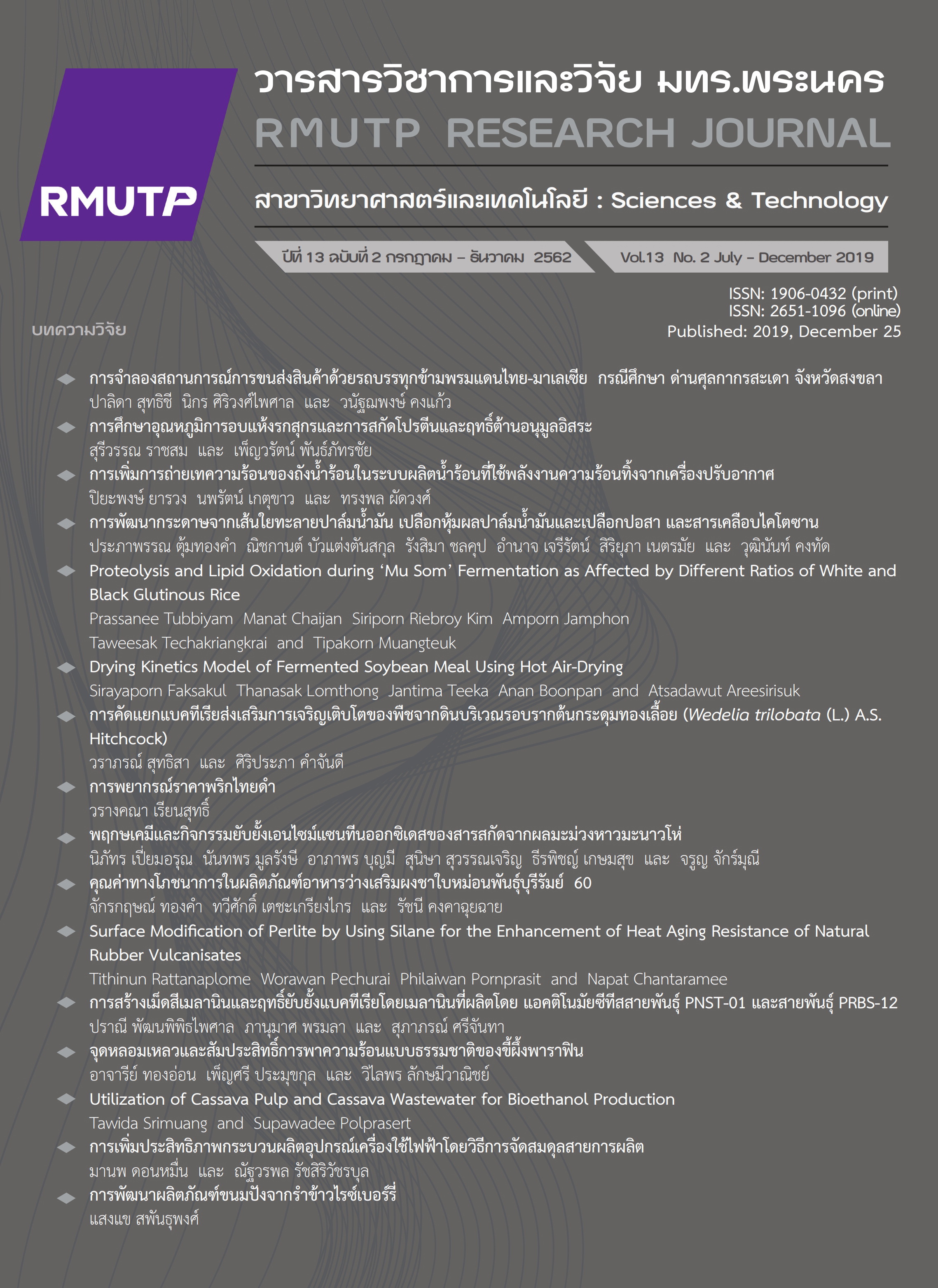Melting Point and Natural Convective Heat Transfer Coefficient of Paraffin Wax
Main Article Content
Abstract
This research was aimed to study melting behavior of paraffin wax and to evaluate the natural heat convection coefficient of solid cylinder paraffin wax. Two grades of white commercial grade and yellow market grade of solid paraffin wax were studied. Three sizes of flat test tube having diameter of 1.5, 2.0 and 2.5 centimeters were used. Three different amount of paraffin, indicated from sample heights of 5, 7 and 10 centimeters, were set. The results found the melting point of the unknown amount of carbon atom–paraffin ranged from 44 to 77 Celsius. Based on the numerical analysis, cooling data of solid cylinder paraffin from around 50 Celsius to room temperature of about 30 Celsius were used for natural convection coefficients evaluation, which was found to be ranged from 3 to 9 W/m2 oC. Mass independent properties were found on both melting point and natural convection coefficient.
Article Details
References
N. Ukrainczyk, S. Kurajica and J. Sipusic, “Thermophysical Comparison of Five Commercial Paraffin Waxes as Latent Heat Storage Materials,” Chemical and Biochemical Engineering Quarterly, vol. 24, no. 2, pp. 129-137, Jul. 2010.
B. Viswanathan, Energy Sources: Fundamental of Chemical Conversion Processes and Application, 1st ed. Amsterdam: Elsevier, 2016.
D. Berit and W. I. B. Anders, “Effect of Active Hand Exercise and Wax Bath Treatment in Rheumatoid Arthritis Patients,” Arthritis Care and Research, vol. 5, no. 2, pp. 87-92, Jun. 1992.
J. Zmywaczyk, P. Zbinkowski, H. Smogor, A. Olejnik and P. Koniorczyk, “Cooling of High-Power LED Lamp Using a Commercial Paraffin Wax,” International Journal Thermophysics, vol. 38, no. 3, pp. 45, Mar. 2017.
M. El-Kotb, A. El-Sharkawy, M. N.El Chazly, N.M. Khattab and S. El-Deeb, “Thermal Characteristics of Paraffin Wax for Solar Energy,” Energy Sources, vol. 20, no. 12, pp. 1113-1126, Sep. 2006.
M. Vollmer, “Newton’s law of cooling revisited,” European Journal of Physics, vol. 30, pp. 1063-1084, Jul. 2009.
R. Conti, A. A. Gallitto and E. Fiordilino (2014, January 1). Measurement of the convective heat-transfer coefficient. [Online]. Available: https://arxiv.org/pdf/
0270.pdf
B.R. Kusse and E.A. Westwig, Mathematical Physics: Applied Mathematics for Scientists and Engineers, 2nd ed. New York: John Wiley and Sons, 2006.
B. Sherman, Candle Making, New York: M. Evans and Company, 2002.
D. Fisher. (2019, September 30). Paraffin Wax for Making Candles. [Online]. Available: https://www.thesprucecrafts
.com/paraffin-wax-for-making-candles-517274
D. Ewen, N. Shurter and P.E. Gundersen, Applied Phsics, 10th ed. Boston: Prentice Hall, 2012.


